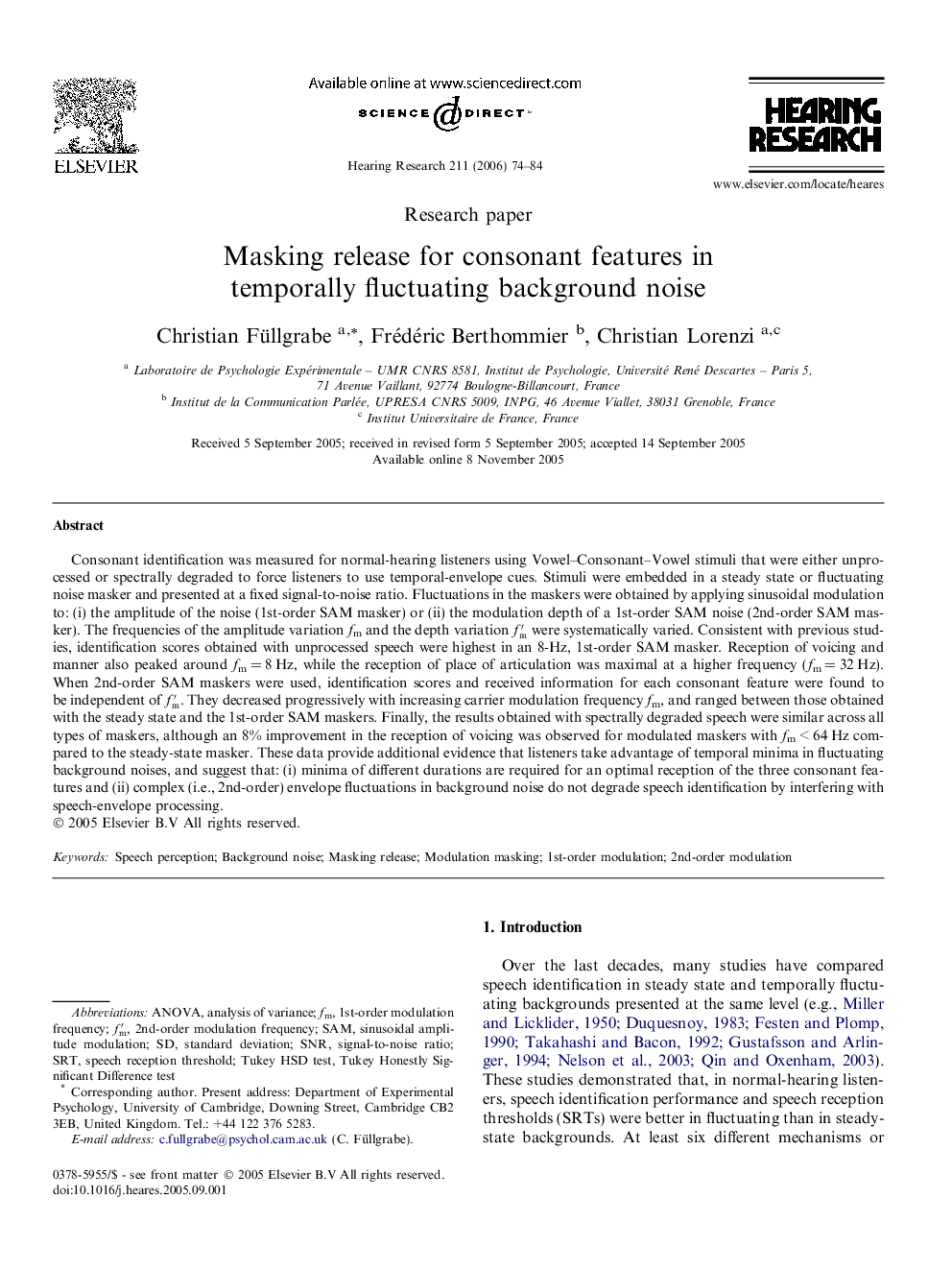| کد مقاله | کد نشریه | سال انتشار | مقاله انگلیسی | نسخه تمام متن |
|---|---|---|---|---|
| 4356560 | 1615687 | 2006 | 11 صفحه PDF | دانلود رایگان |
عنوان انگلیسی مقاله ISI
Masking release for consonant features in temporally fluctuating background noise
دانلود مقاله + سفارش ترجمه
دانلود مقاله ISI انگلیسی
رایگان برای ایرانیان
کلمات کلیدی
SAMSNRsRTFm′ - Fm 'Speech reception threshold - آستانه دریافت گفتارSpeech perception - ادراک گفتاری یا درک گفتارMasking release - انتشار ماسکstandard deviation - انحراف معیارanalysis of variance - تحلیل واریانسANOVA - تحلیل واریانس Analysis of varianceBackground noise - صدای زمینهSinusoidal amplitude modulation - مدولاسیون دامنه سینوسیSignal-to-noise ratio - نسبت سیگنال به نویز
موضوعات مرتبط
علوم زیستی و بیوفناوری
علم عصب شناسی
سیستم های حسی
پیش نمایش صفحه اول مقاله

چکیده انگلیسی
Consonant identification was measured for normal-hearing listeners using Vowel-Consonant-Vowel stimuli that were either unprocessed or spectrally degraded to force listeners to use temporal-envelope cues. Stimuli were embedded in a steady state or fluctuating noise masker and presented at a fixed signal-to-noise ratio. Fluctuations in the maskers were obtained by applying sinusoidal modulation to: (i) the amplitude of the noise (1st-order SAM masker) or (ii) the modulation depth of a 1st-order SAM noise (2nd-order SAM masker). The frequencies of the amplitude variation fm and the depth variation fmâ² were systematically varied. Consistent with previous studies, identification scores obtained with unprocessed speech were highest in an 8-Hz, 1st-order SAM masker. Reception of voicing and manner also peaked around fm = 8 Hz, while the reception of place of articulation was maximal at a higher frequency (fm = 32 Hz). When 2nd-order SAM maskers were used, identification scores and received information for each consonant feature were found to be independent of fmâ². They decreased progressively with increasing carrier modulation frequency fm, and ranged between those obtained with the steady state and the 1st-order SAM maskers. Finally, the results obtained with spectrally degraded speech were similar across all types of maskers, although an 8% improvement in the reception of voicing was observed for modulated maskers with fm < 64 Hz compared to the steady-state masker. These data provide additional evidence that listeners take advantage of temporal minima in fluctuating background noises, and suggest that: (i) minima of different durations are required for an optimal reception of the three consonant features and (ii) complex (i.e., 2nd-order) envelope fluctuations in background noise do not degrade speech identification by interfering with speech-envelope processing.
ناشر
Database: Elsevier - ScienceDirect (ساینس دایرکت)
Journal: Hearing Research - Volume 211, Issues 1â2, January 2006, Pages 74-84
Journal: Hearing Research - Volume 211, Issues 1â2, January 2006, Pages 74-84
نویسندگان
Christian Füllgrabe, Frédéric Berthommier, Christian Lorenzi,